|
|
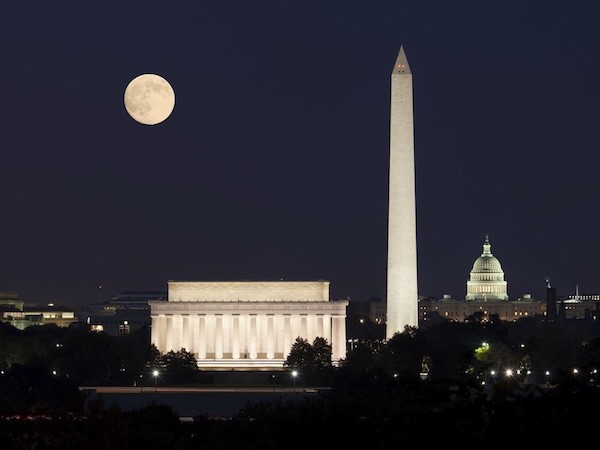
Reunion Hotel Information
Washington, DC - 2021
Tour Schedule Continued
NOTE: WE WILL HAVE TO SHOW ID's AND PASS THROUGH SECURITY INCLUDING METAL DETECTORS TO VISIT MOST FEDERAL FACILITIES ON OUR TOURS. ANY METAL ITEMS SHOULD BE LEFT AT THE HOTEL OR ON THE BUS. FOLLOW THIS LINK TO A LIST OF PROHIBITED ITEMS FOR THE CAPITOL BUILDING. SOME OF THE ITEMS ARE OBVIOUS BUT SOME ARE NOT SUCH AS LIQUIDS INCLUDING WATER. THIS LIST SHOULD BE A GOOD GUIDE FOR MOST FEDERAL FACILITIES.
Friday, August 27th $ TBD, 9:30 AM Departure to the Washington Navy Yard and the US Capitol Building.
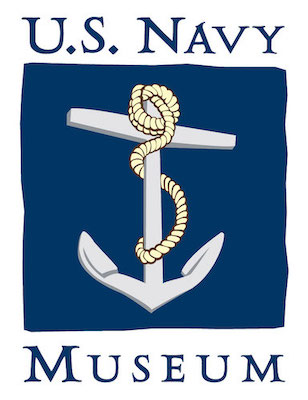 
At the Washington Navy Yard we will be able to explore both The National Museum of The US Navy and the Cold War Museum. Admiral Arleigh Burke established the current museum, Building 76, in 1963 to create an American naval history museum comparable to those in Europe. Permanent and temporary exhibitions commemorate the Navy's wartime heroes and battles as well as its peacetime contributions in exploration, diplomacy, space flight, navigation and humanitarian service. Today The U.S. Navy Museum is the only naval museum to chronicle the history of the U.S. Navy from its to those in Europe. Permanent and temporary exhibitions commemorate the Navy's wartime heroes and battles as well as its peacetime contributions in exploration, diplomacy, space flight, navigation and humanitarian service. Today The U.S. Navy Museum is the only naval museum to chronicle the history of the U.S. Navy from its  creation to the present. Artifacts like USS Constitution's fighting top, the world's deepest diving submersible, Trieste, and the khaki uniform of former Fleet Admiral Chester W. Nimitz make The Navy Museum's collection second to none. creation to the present. Artifacts like USS Constitution's fighting top, the world's deepest diving submersible, Trieste, and the khaki uniform of former Fleet Admiral Chester W. Nimitz make The Navy Museum's collection second to none.
There are many permanent exhibits including:
- The National Museum of the U.S. Navy's Cold War Gallery is located in Building 70. The gallery exhibits the U.S. Navy's history from the Korean War, through the Vietnam War, and the Cold War era, focusing on covert submarine operations, nuclear submarine equipment, and models of period aircraft.
- Dive! Dive! U.S. Navy Submarines
This large room is dedicated entirely to the history of American submarines. The room features a pair of working periscopes, targeting computers, and battle flags.
- The Forgotten Wars of the Nineteenth Century
This exhibit features artifacts from the Quasi-War with France, the First Barbary War and the Second Barbary War, the War of 1812, and the Mexican–American War. The centerpiece of this exhibit is a replica of USS Constitution gun deck.
- Civil War
The Civil War exhibit shows the sorts of warships and equipment used by sailors of the Union and Confederate fleets. Models of the legendary ironclads USS Monitor and CSS Virginia, the commerce raider CSS Alabama, and the USS Kearsarge (1861) are on display.
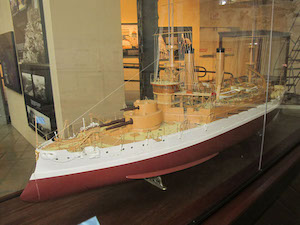
- Spanish–American War
This exhibit tells the story of the loss of the battleship USS Maine (ACR-1), public outrage and the beginning of the United States as a global power. On display are a number of weapons, items from the home front, a model and diagram of the strange USS Vesuvius (1888), and the uniform of Admiral George Dewey.
 - U.S. Navy in World War I
This exhibit detailing the U.S. Navy's brief involvement in the First World War explains the dangerous task of submarine-hunting and showcases models of warships of the period, a captured German flag and footage of a U.S. Navy railway gun in action.
- In Harm's Way, The Navy in World War II
The largest section of the museum, In Harm's Way is divided into three sections.
- The Atlantic Theater: This exhibit details convoy protection, the capture of U-505, the breaking of the German Enigma code, and the role of the Merchant Marine, as well as weapons and equipment used by both sides of the war for Europe. A wide variety of cannon, rifles and sidearms are on display along with a high-altitude flying suit, the diving log of U-505 and the XAF Radar Receiver from the battleship USS New York (BB-34).
- The Home Front: Featuring a replica storefront and a small theater showing film from the World War II period, the home front exhibit is decorated with patriotic posters, aircraft-identification models, and personal items. The role of WAVES is detailed in the exhibit.
- The Pacific Theater: The area dedicated to the war in the Pacific dominates the World War II section of the museum, featuring a full-size replica of the bridge of the destroyer USS Fletcher, four gun batteries, an FG-1D Corsair, a Japanese MXY7 Ohka kamikaze aircraft, two atomic bomb casings, and models of the carrier USS Leyte (CV-32) and battleship USS Missouri (BB-63), each around twenty feet in length.
- Korea 1950–53: The Navy in the Forgotten War
Uniforms and equipment, along with videos and other artifacts, bring the often-ignored Korean War into focus. Captured Soviet weapons, models of aircraft and warships and even a chunk of the Inchon seawall are on display.
Before we depart for the US Capitol Building LUNCH IS ON YOUR OWN in one of the many eateries nearby.
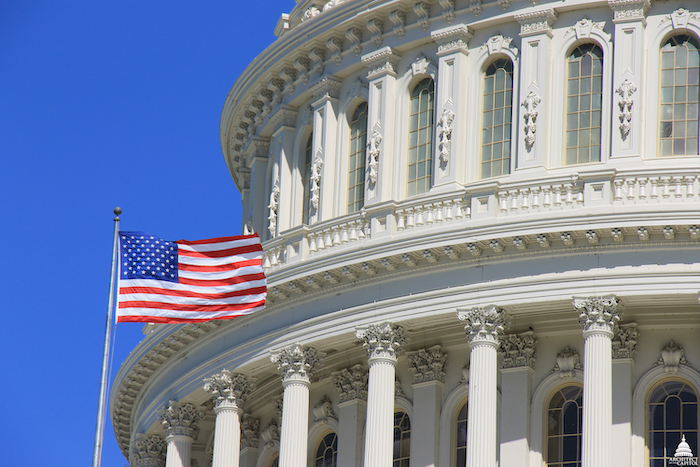
After lunch we will tour The United States Capitol Building. The United States Capitol is among the most symbolically important and architecturally impressive buildings in the nation. It has housed the meeting chambers of the House of Representatives and the Senate for two centuries.
The cornerstone was laid by President Washington on September 18, 1793. 1800 saw the completion of the north wing in time for the first session of Congress on November 17, 1800. In 1803, construction resumed to comple the south and north wings with the wings connected by a temporary wooden passageway. On August 24, 1814, British troops set fire to the building during the War of 1812. Only a rainstorm prevented its complete destruction. 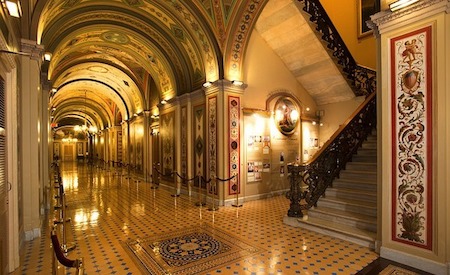 By 1850, the Capitol could no longer accommodate the increasing numbers of senators and representatives. By 1850, the Capitol could no longer accommodate the increasing numbers of senators and representatives.
As the wings progressed, they more than doubled the length of the Capitol making the dome too small for the new proportions. In 1856, the old dome was removed and work began on a replacement with 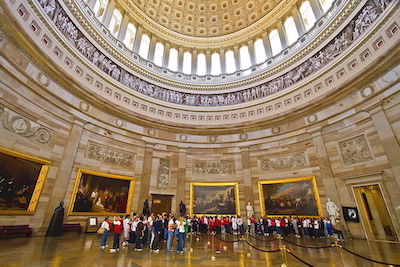 a new, fireproof cast-iron dome. Construction was suspended in 1861 so that the Capitol could be used as a military barracks, hospital and bakery for the Civil War. However, in 1862, construction resumed, because Lincoln believed that the Capitol must go on, just as the Union must go on. The work on the dome and extensions was completed in 1868. a new, fireproof cast-iron dome. Construction was suspended in 1861 so that the Capitol could be used as a military barracks, hospital and bakery for the Civil War. However, in 1862, construction resumed, because Lincoln believed that the Capitol must go on, just as the Union must go on. The work on the dome and extensions was completed in 1868.
Interestingly it is no exaggeration to say that on Sundays in Washington during the administrations of Thomas Jefferson (1801–1809) and of James Madison (1809–1817) the state became the church. Within a year of his inauguration, Jefferson began attending church services in the chamber of the House of Representatives. Madison followed Jefferson's example, although unlike Jefferson, who rode on horseback to church in the Capitol, Madison came in a coach and four. Worship services in the House—a practice that continued until after the Civil War—were acceptable to Jefferson because they were nondiscriminatory and voluntary. Preachers of every Protestant denomination appeared. (Catholic priests began officiating in 1826.) As early as January 1806 a female evangelist, Dorothy Ripley, delivered a camp meeting-style exhortation in the House to Jefferson, Vice President Aaron Burr, and a "crowded audience".
Final Day of Reunion
9:00 AM Business meeting for all shipmates.
9:00 AM Ladies 50's 60's music trivia contest with fabulous prizes!
6:30 PM Banquet tonight - $ TBD,
The rest of the day will be free to explore some of the area's many attractions listed on the "Great Area Attractions page.
Return to page 1 for First Day's Tours
Great Area Atttractions
Return to Reunions Page
|







